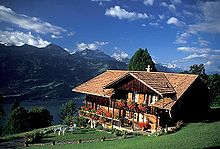Beatenberg
Beatenberg is a municipality in the Interlaken district of the canton of Bern in Switzerland.
[3] The earliest trace of a settlement in the area are some early medieval graves near the Beatushöhlen (Saint Beatus cave).
According to legend, Saint Beatus was a Scottish or Irish monk who was sent to evangelize the Helvetii.
After finding success in the Jura Mountains, he moved into the Beatenberg area where he defeated a dragon and established a hermitage in the cave overlooking Thun Lake.
By 1230 the chapel had grown into a parish church, which in the following century was brought under the control of Interlaken Monastery.
[3] During the 13th century a number of local nobles owned land or rights in and around the area.
However, in 1528, Bern adopted the Protestant Reformation and secularized Interlaken Monastery.
Following the 1798 French invasion and the Act of Mediation in 1803, Beatenberg became part of the newly recreated Interlaken District.
In the 18th century several wool spinning mills moved into the village and provided additional income.
The tourism industry remained depressed until 1959, when Beatenberg rebuilt itself as a place for vacation homes and weekend visits.
[3] Beatenberg is located in the Bernese Oberland on a steppe beneath the Niederhorn and high above Lake Thun.
[6] The blazon of the municipal coat of arms is Argent a Wyvern rampant Vert langued Gules on dexter and Saint Beatus clad Sable haloed Or with holding in sinister a Book leathered Gules and in dexter raised a stick Sable.
[10] Most of the population (as of 2000[update]) speaks German (1,185 or 92.7%) as their first language, Serbo-Croatian is the second most common (20 or 1.6%) and Dutch is the third (15 or 1.2%).
According to legend, Beatus was a missionary who came from Ireland to Lake Thun and who there expelled a dragon from the caves above Sundlauenen.
Even today, the kilometer-long limestone cave with its subterranean lakes is a main tourist attraction of the locality.
[10] There were 634 residents of the municipality who were employed in some capacity, of which females made up 48.4% of the workforce.
In the tertiary sector; 21 or 7.3% were in wholesale or retail sales or the repair of motor vehicles, 19 or 6.6% were in the movement and storage of goods, 130 or 45.3% were in a hotel or restaurant, 7 or 2.4% were technical professionals or scientists, 10 or 3.5% were in education and 69 or 24.0% were in health care.
[10] From the 2000 census[update], 118 or 9.2% were Roman Catholic, while 888 or 69.4% belonged to the Swiss Reformed Church.
This is followed by three years of obligatory lower Secondary school where the students are separated according to ability and aptitude.
Following the lower Secondary students may attend additional schooling or they may enter an apprenticeship.
[17] During the 2010–11 school year, there were a total of 133 students attending classes in Beatenberg.






